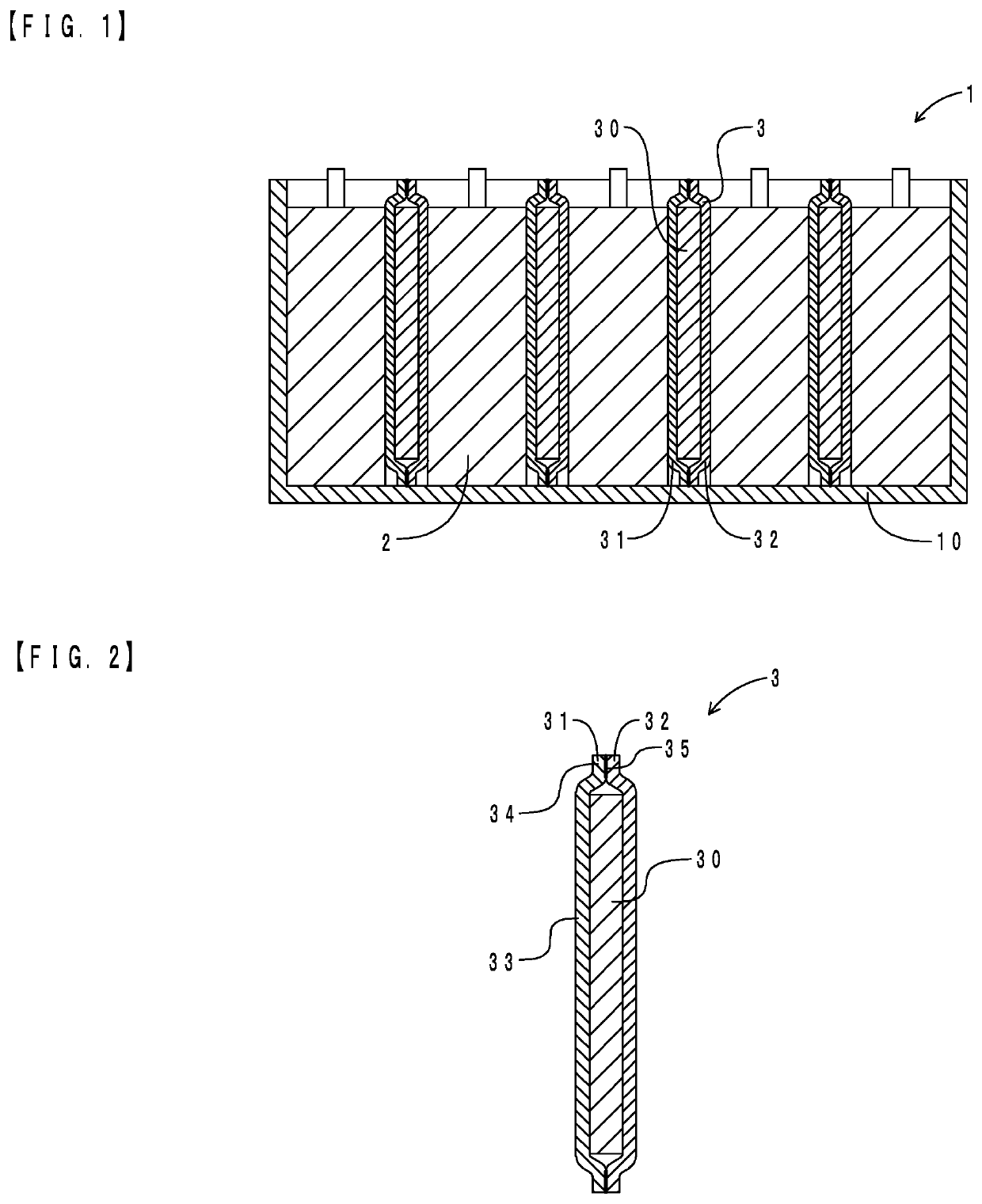Thermal insulation material for battery pack and battery pack
a technology of thermal insulation material and battery pack, which is applied in the field of thermal insulation materials, can solve the problems of thermal insulation material not being able to retain its shape, gas production or cracking may occur, and urethane binder that is an organic component may be decomposed and deteriorated, so as to achieve the desired thermal insulation properties, reduce the shedding of porous structure, and not easily crushed
- Summary
- Abstract
- Description
- Claims
- Application Information
AI Technical Summary
Benefits of technology
Problems solved by technology
Method used
Image
Examples
first embodiment
[0027]First, the configuration of a thermal insulation material for a battery pack (hereinafter sometimes simply referred to as the “thermal insulation material” in the description of the embodiment) and a battery pack of a first embodiment will be described. FIG. 1 is a schematic sectional view illustrating the configuration of the battery pack of the present embodiment. FIG. 2 is a sectional view of the thermal insulation material housed in the battery pack. FIG. 3 is a front view of the thermal insulation material. In FIG. 3, a thermal insulation layer is shown as seen through by dashed line for convenience of explanation. As shown in FIGS. 1 and 2, a battery pack 1 has a housing 10, a plurality of battery cells 2, and a thermal insulation material 3.
[0028]The housing 10 is made of metal and has a box shape. The battery cells 2 are lithium ion batteries. Each battery cell 2 is in the shape of a rectangular thin plate, and the battery cells 2 are stacked in the thickness direction...
second embodiment
[0038]A thermal insulation material and a battery pack of the present embodiment are different from those of the first embodiment in that a fixing member rather than the fused portion is placed in the peripheral edge portion of the thermal insulation material. The following description focuses on the difference. FIG. 4 is a sectional view of the thermal insulation material of the present embodiment. FIG. 4 corresponds to FIG. 2, and the same portions as those in FIG. 2 are denoted by the same signs as those in FIG. 2.
[0039]As shown in FIG. 4, the thermal insulation material 3 has the thermal insulation layer 30, the first base material 31, and the second base material 32. The thermal insulation layer 30 is sandwiched between the first base material 31 and the second base material 32 that are made of a glass cloth. The thermal insulation material 3 has the body portion 33 and the peripheral edge portion 34. A fixing member 36 is placed in the peripheral edge portion 34, that is, betw...
examples
[0069]Next, the present invention will be described in more detail using examples.
[0070](1) Manufacturing of Thermal Insulation Material for Battery Pack
[0071]First, various coating materials for a thermal insulation layer were prepared according to the amounts (unit: parts by mass) shown in Tables 1 and 2 below. Next, the surface of a first glass cloth is coated with each of the prepared coating materials for a thermal insulation layer with a thickness of 2 mm. Then, a second glass cloth was placed on the coating film to form a laminate. The laminate was placed in a hot air oven and held at 80° C. for 1 hour, and then heated to 100° C. and dried until the mass no longer decreased. A sheet-like thermal insulation material sample composed of the first glass cloth, the thermal insulation layer, and the second glass cloth was thus manufactured. The first glass cloth is included in the concept of the first base material in the present invention, and the second glass cloth is included in...
PUM
| Property | Measurement | Unit |
|---|---|---|
| length | aaaaa | aaaaa |
| length | aaaaa | aaaaa |
| length | aaaaa | aaaaa |
Abstract
Description
Claims
Application Information
 Login to View More
Login to View More - R&D
- Intellectual Property
- Life Sciences
- Materials
- Tech Scout
- Unparalleled Data Quality
- Higher Quality Content
- 60% Fewer Hallucinations
Browse by: Latest US Patents, China's latest patents, Technical Efficacy Thesaurus, Application Domain, Technology Topic, Popular Technical Reports.
© 2025 PatSnap. All rights reserved.Legal|Privacy policy|Modern Slavery Act Transparency Statement|Sitemap|About US| Contact US: help@patsnap.com


